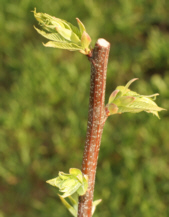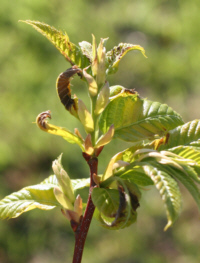|
The Farm Log
Farming can either be low
risk with low return or it can be a
high risk undertaking with little chance of recovery of the investment
in time and money. The Washington Chestnut Company Farm is a high risk
undertakeing because there are so few others are entering into the commercial
chestnut production in the United States. Within this area of the web
site we will be providing our clients information about our successes
and our failures. Lets start with the early spring of 2006.
Early Spring 2006
The planning and purchase of inital equipment, land lease contract, and
buying the trees is performed. We selected
Burnt Ridge Nursery as our single source provider of trees. Their
knowledge of our
local environment and weather conditions aided signifcantly in
selecting them. We also
set a investment schedule for purchasing equipment like a 18" 3-point
post hole digger,
54" 23 hp mower, and other small purchases. The cost per acre is not
significant because
many of the costs are fixed one time purchases and local employment
costs vary by local.
The one thing with the highest variability is how many trees per acre
you plant to start
with. There are many economic models to work from. Since we will see
small trees even
when they are mature we are placing about 90 trees to the acre.
One of the problems being so far north is late frosts. Our last normal
frost date
is April 28th. This could be a problem since the chestnut trees will
want to leaf
out in late April to the first part of May. Over time trees that leaf
out to early
will die off and be replaced with new trees. Most the the late frosts
rarely occure with tempertures below 29 degrees.

This picture is of a young chestnut tree leafing out. It is important
to
notice the formation of the new branches and the formation of the
leafs. If
frost damages the new leafs the frost damage will most likely show on
the
edges of the new leafs. If the frost was a hard one, the entire new
structure could be damaged and will turn brown in just a day or so.
Some
people feel at this point in the growth cycle the trees will present
problems
if they are present. First and formost check for uniform leafs. To many
oddly
formed leafs could indicate a nutritional problem or the presents of
damaging
fungus or herbicide damage. If the problem extends to a number of trees
it would
be wise to contact a master gardener or the agricultural extension
service for
further investigation.

Here is a photograph showing some frost damage to some of the forming
leafs and newly formed structure. Some of the chestnut varieties are
more prone to frost damage than others. This tree with frost damage is
a Basalta #3.
Some nearby chestnut varieties are Marigoule and Marival. These trees
did not
have any frost damage. This does not mean Basalta #3 is more susuable
to frost
damage than other varieties. It does demonstrate there are times in the
formation of leafs and structures where frost can cause damage no
matter
how hardy a tree might be.
Summer
2006
This summer has been a dryer than normal season. In a normal summer we
get at least 2 inches of rain between the end of June and the end of
September. We irragated 2 times with an average of about 2.5
inches of rain each time. There were a few trees that reveived to much
water. These trees may die due to the wet roots. The fields were
lacking nitrogen resulting in poor leaf color (yellow instead of a deep
green) and less than normal new growth. Many of the layered and grafted
trees blossemed and had burrs.
To correct the shortage of nitrogen we applied wetable complete
fertilizer with micronutrients to the leaves. By mid to late summer the
trees were recovering with deepening green in the leaves. The growth
was still below expectations so a small amount of 16-16-16 was applied
subsoil at the edge of the planting hole dug when the tree was
planted. By the end of summer most of the trees were putting on
nice growth.
Fall 2006
This fall has been a dryer than normal. It rained only once in
September and did not rain again until mid October. The first frost
this year came on September 29th. For the next 4 nights the night time
lows were reaching below 30. By the first week of October the Nooksack
tree started dropping empty nuts. By mid October daytime
tempertures are reaching the high 50's and the overnight lows are in
the mid 40's. The Marival tree dropped its first empty nuts on October
16th.
In the late summer soil and leaf analysis were performed. The soil analysis results
are in the tables below.
Soil Analysis of Mineral Based Soil
| Component | Results |
| Organic Matter | 6.1% |
| Phosphorus | 50 ppm |
| Potassium | 289 ppm |
| Magnesium | 173 ppm |
| Calcium | 1877 ppm |
| Sodium | 59 ppm |
| pH | 5.6 |
| Nitrogen | 34 ppm |
| Sulfur | 13 ppm |
| Zinc | 1.7 ppm |
| Manganesse | 5 ppm |
| Iron | 96 ppm |
| Copper | 1.8 ppm |
| Boron | 0.5 |
Soil Analysis of Organic Based Soil
| Component | Results |
| Organic Matter | 47.9% |
| Phosphorus | 4 ppm |
| Potassium | 58 ppm |
| Magnesium | 226 ppm |
| Calcium | 5235 ppm |
| Sodium | 325 ppm |
| pH | 5.4 |
| Nitrogen | 105 ppm |
| Sulfur | 26 ppm |
| Zinc | 1.8 ppm |
| Manganesse | 3 ppm |
| Iron | 130 ppm |
| Copper | 0.6 ppm |
| Boron | 2.2 |
These results are without amending the soils
in the past 2 years. Prior years the mineral based soil had sweet corn grown on it.
The soil amendments from those prior farming activities has resulted in the P-K-N
readings being higher than normal.
We collected chestnut leaves in early September and sent them to Soiltest
Farm Consultants, Inc in Moses Lake, WA. In the future we will use A & L
Wester Agricultural Labortories in Portland, OR. They provide excelent service
and have significantly more experience with working with nut producers.
Leaf Analysis of Chestnut Leaf Sample
| Component | Results |
| Nitrogen (NO3) | 3% |
| Sulfur | 0.24% |
| Phosphorus | 0.20% |
| Potassium | 0.80% |
| Magnesium | 0.23% |
| Calcium | 1.19% |
| Zinc | 44 ppm |
| Manganesse | 510 ppm |
| Iron | 142 ppm |
| Copper | 7 ppm |
| Boron | 48 ppm |
Planning is underway for the 2007 planting of chestnut trees and preparing
fields for tree plantings in 2008 and 2009. Most of the work in preparing fields for
future plantings is leveling the soil, removing brush, planting orchard grass, and
laying out the plot for the trees. One of the problems we are working to resolve
is designing a fertilizer plan for the trees based on the soil analysis. Since
we have 2 very different soil types we are going to use 2 different fertilizer
formulations. For what is locally called peat soil, the formulation (yet to be
reviewed by a fertilizer expert) is N-0%, P-19%, K-19%, Copper-2%. For the mineral
based soil the formulation N-16% (urea 75%, amonium sulfate 25%), P-0%, K-8%,
magnesium-2%, sodium-2%, Boron 2%. These formulations are up for review. One pound
of fertilizer will be applied to the soil surface under the canopy of each tree.
The best growth of any one chestnut tree for this year was from a Colassal
grafted tree. At the start of the season the tree was 3.5 feet tall. At the
end of the growing season the tree was 6.9 feet tall. The tree is in a mineral
based soil classified as a the world reknown great growing medium -sandy loam-.
At the end of the 2006 year the best advise for those trying to start a
comercial chestnut orchard is:
Check your soils with a professional soil analysis lab
In early August have a leaf analysis performed
Don't let the soil dry out during the first growing season for new trees
Don't overwater during the growing season - this will kill trees
- See the Wet Trees page
The experts say "Don't fertilize the first year." If your soil has
deficiencies, correct them with fertilizer as soon as they are discovered
If you want nut production quick, don't prune your trees
If you want a health strong orchard prune whenever needed
There is no standards for growing chestnuts - your a pioneer, do
your best and pray over the rest
|


